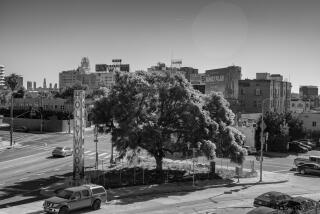Cyperus papyrus PapyrusTall ornamental with...
- Share via
Cyperus papyrus Papyrus
Tall ornamental with branchlets.
In ancient Egypt, papyrus virtually lined the valley of the Nile. Now the tall, graceful bog plant is reportedly nearly extinct there. Fortunately, it was interesting-looking enough that someone at some point thought to bring it to the New World, probably for its ornamental value.
The ancient Egyptians had more practical uses for it: Not only did they use the roots for fuel and eat the pith of the stem, they made paper (the word paper is from the Greek papyros for reed) from it. The sticky strips of pith were laid side by side, upon which more strips were placed at a perpendicular angle to the first layer. This was then soaked and pressed.
Modern Papyrus
One place to see the modern papyrus, with its tufted stems reaching 6 to 10 feet, is at the north edge of the lagoon at the Los Angeles State and County Arboretum in Arcadia. A more accessible colony overruns a small plot at Beverly Glen and Sunset boulevards.
The grass-like papyrus is not a true grass but a sedge, which is characterized by triangular, solid stems. The sedge family, Cyperaceae, according to Hortus Third, is a family whose greatest value is “in stabilizing soils in extensive wet areas of the world.”
In the common garden, then, its roots need to sit in very moist soil or in shallow water. Plant it in sun or shade in a huge container as a focal point of a courtyard or patio. Or place it in a pot and sink it into a cool, quiet water garden. If the roots freeze, the plant will die (those planted in containers are most susceptible to freezing temperatures), but if only the material above ground freezes, the plant has a good chance of coming back.
Two for One
To prevent the plant from looking unkempt, cut down the stems that start to turn brown. But be wary: It is said that for every stem that is cut down, two come up. Papyrus is on the official Los Angeles menace plant list, often invading areas where it is unwanted. Divide the clumps when they get too big.
David Lofgren, botanical information consultant at the Arboretum, suggests that when papyrus is planted initially, to reduce the likelihood of its taking off to a running start, cut the bottom out of a plastic bucket, place the clumps inside, and plant the whole thing in the ground.






